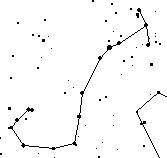|
TRANSLATIONS
Given the signs of bending around and of humpback, it is time to look again at the structure of the calendar in K.
Possibly we should relocate period 20 to the following group, and if so, then a mirrored changed ought to be made by moving period 13 to the preceding group:
The resulting new numbers 15 and *26 are reasonable - possibly marking the final of moon respectively of sun. Also, the geometric progression in number of periods in the groups are beautíful: 4, 2, 1 mirrored as 1, 2, 4. Another possibility is to group together periods 16-17 and reach *16 glyphs. The pattern then becomes: 28 + 15 + *16 + *26 + 30 + 10 = 43 + *42 + 40 = *125 Wouldn't it then be nicer with 41 instead of 40, reaching *126? 6 * 21 = 3 * 42 = 121
The mago glyphs in period 6, are they signs which should make us reconsider the structures in G and K?
There are 3 'humpbacks' among the kai glyphs in K, blackmarked below because they carry no henua. A hump excludes a henua in front - henua glyphs indicate sunlight.
The boat-like henua sign in Ka4-15 is reversed in Kb3-8 and I have redmarked them to focus our attention. Moreover, in Kb2-110 we can see the final of the season which appears to begin at Ka4-15.
The final of the 23rd period is definitely connected with a reflection of the 6th period. Counting periods long (inclusively), we get 1 + 16 + 1 = 18 periods, counting them short (exclusively) we get 16 periods. A short count could be used for the prominent part of a moon calendar, while counting long could be used for the prominent part of a sun calendar. Counting glyphs long by including all glyphs in the 6th period we reach 3 + 6 + *28 + *29 = *66. Counting short (excluding all glyphs in the 6th period, and also all those in the 23rd period, we get *66 - 3 - 2 = *61. Neither result is convincing. If we relocate period 0 to the beginning of the calendar (a step we should have taken much earlier), we reach 29 with Ka4-15, as if the period of darkness ends at the mago period (6):
I at the same time have increased period 32 from 3 to 4 glyphs. But I have not changed the accumulated sums (14, 22, 28 etc) - with the exception of *126. I have not changed the number of glyphs for period 0. It is still listed as 7 glyphs, although evidence points to it containing maybe only 2 glyphs:
These two glyphs maybe stand for the two halves of the year. Instead of *126 we would then have *121 (= 11 * 11). Or we could once again set period 32 as 3 glyphs, giving the more satisfactory *120. Let us try out this solutin:
The solution appears satisfactory. For instance: 365 - 360 = 5 = the number of glyphs in period 32 together with those in period 0:
Is this the way to bind the years together? 5 + 3 = 8 and 6 + 14 = 20. Back to the basic questions: It seems probable that mago indicates how light arrives and the humpback how darkness arrives. Is mago a symbol for Ana-mua, the entrance, and the humpback a symbol for Ana-muri, the exit?
Antares is the bright star close to the head (right) in the outline of Scorpio above. |
||||||||||||||||||||||||||||||||||||||||||||||||||||||||||||||||||||||||||||||||||||||||||||||||||||||||||||||||||||||||||||||||||||||||||||||||||||||||||||||||||||||||||||||||||||||||||||||||||||||||||||||||||||||||||||||||||||||||||||||||||||||||||||||||||||||||||||||||||||||||||||||||||||||||||||||||||||||||||||||||||||||||||||||||||||||||||||||||||||||||||||||||||||||||||||||||||||||||||||||||





































